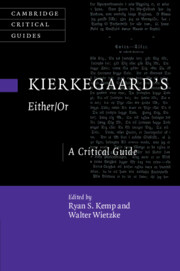Book contents
- Kierkegaard’s Either/Or
- Cambridge Critical Guides
- Kierkegaard’s Either/Or
- Copyright page
- Contents
- Contributors
- Acknowledgments
- Abbreviations
- Introduction
- Chapter 1 Existential Melancholia
- Chapter 2 Don Giovanni and the Musical-Erotic
- Chapter 3 For What May the Aesthete Hope?
- Chapter 4 Companions in Guilt
- Chapter 5 A’s Religion of Boredom
- Chapter 6 The Artist Is Not Present
- Chapter 7 Failed Temporalities in Either/Or
- Chapter 8 Love, Marriage, and Delusion in Either/Or
- Chapter 9 The Philosophy of Science in Either/Or
- Chapter 10 The Despair of Judge William
- Chapter 11 The Problem of Evil in Either/Or
- Chapter 12 Illusions of Ethical Independence
- References
- Index
- Cambridge Critical Guides
Chapter 1 - Existential Melancholia
The Affective Psychology of the “Diapsalmata” in Either/Or
Published online by Cambridge University Press: 16 November 2023
- Kierkegaard’s Either/Or
- Cambridge Critical Guides
- Kierkegaard’s Either/Or
- Copyright page
- Contents
- Contributors
- Acknowledgments
- Abbreviations
- Introduction
- Chapter 1 Existential Melancholia
- Chapter 2 Don Giovanni and the Musical-Erotic
- Chapter 3 For What May the Aesthete Hope?
- Chapter 4 Companions in Guilt
- Chapter 5 A’s Religion of Boredom
- Chapter 6 The Artist Is Not Present
- Chapter 7 Failed Temporalities in Either/Or
- Chapter 8 Love, Marriage, and Delusion in Either/Or
- Chapter 9 The Philosophy of Science in Either/Or
- Chapter 10 The Despair of Judge William
- Chapter 11 The Problem of Evil in Either/Or
- Chapter 12 Illusions of Ethical Independence
- References
- Index
- Cambridge Critical Guides
Summary
Kierkegaard’s aesthete, named only as A, continually laments the lack of meaning in his life. He suffers through passions that flare up and quickly die away, leaving him in a melancholic state. His mode of being is on display in the Diapsalmata, the fragmentary writings at the start of Either/Or. In this chapter, we examine why he avoids becoming consistently engaged in the world and remains trapped within his alienated melancholia. We offer a general account of melancholy, arguing that melancholia is an existential condition that must be understood in terms of the metaphysics of possibility. We also provide a sympathetic interpretation of A’s melancholy, rather than placing blame upon him, because melancholia attunes us to certain aspects of the world and of human existence. The aesthetic life has epistemic, moral, and aesthetic worth on its own terms, so a person may legitimately decide to remain melancholic. This avoids compromising our possibilities, makes us receptive to the suffering of others, and may inspire creative activity such as writing poetical fragments.
Keywords
- Type
- Chapter
- Information
- Kierkegaard's Either/OrA Critical Guide, pp. 8 - 24Publisher: Cambridge University PressPrint publication year: 2023

